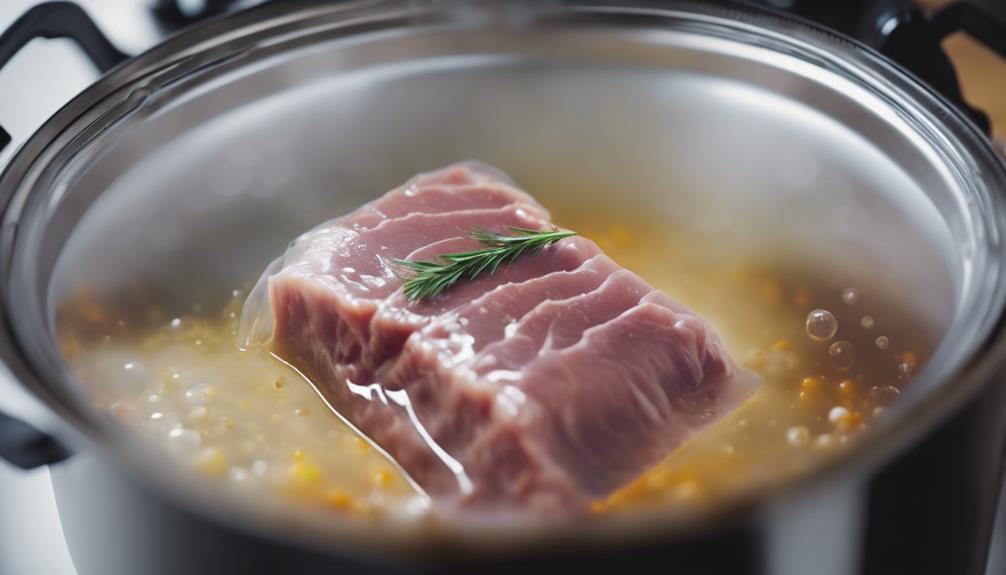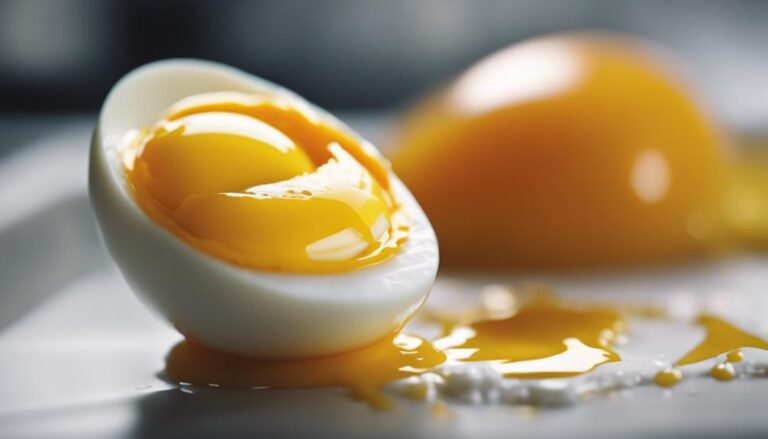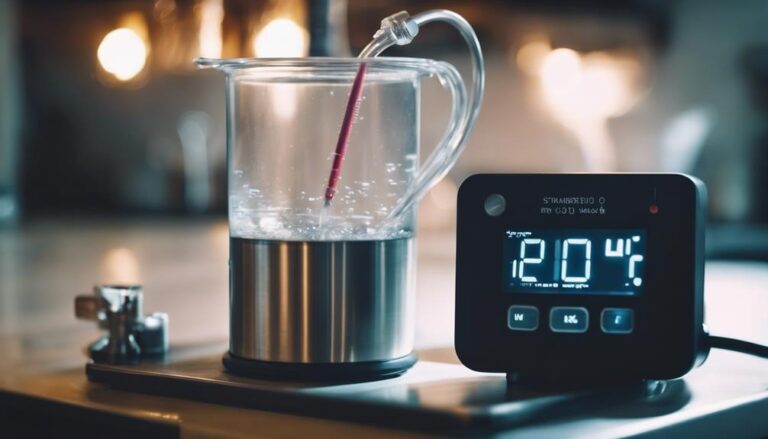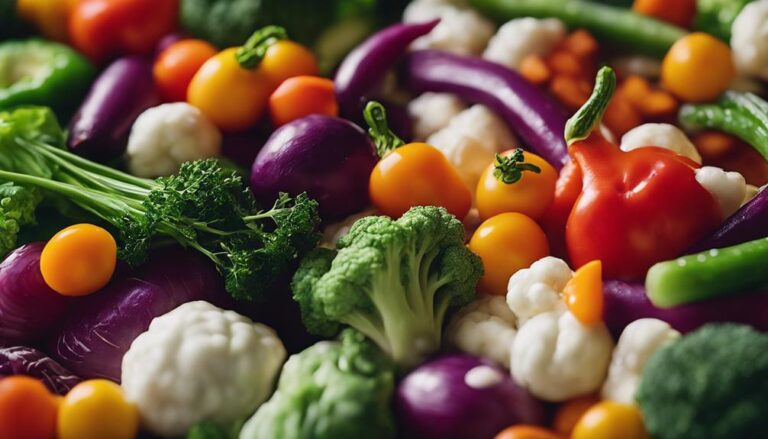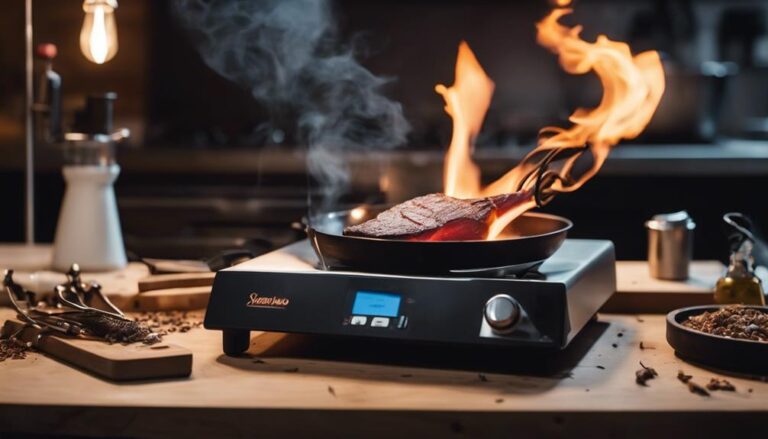Freezing and Reheating Sous Vide Meals: Best Practices
When freezing and reheating sous vide meals, rapid chilling in an ice bath is crucial. This preserves flavor and texture while avoiding bacterial growth. Pack in vacuum-sealed bags with labels to prevent leaks and freezer burn. Reheat at 130°F to 150°F for safety. Thaw in the fridge to maintain moisture and flavor. Maximize your meals by following safe practices throughout. Ready to enhance your sous vide experience?
What You Will Learn Here
- Rapidly chill in ice bath to preserve texture and flavor.
- Vacuum-sealed packaging prevents freezer burn and leaks.
- Reheat at 130°F to 150°F for safe consumption.
- Thaw in refrigerator to maintain moisture and taste.
- Monitor reheating process closely to prevent overcooking.
Proper Cooling Techniques for Freezing
To guarantee high-quality food quality and safety when freezing sous vide meals, rapid chilling in an ice bath is essential. Quick chilling in an ice bath after sous vide cooking helps maintain the texture and flavor of your meals.
By cooling your cooked food rapidly before freezing, you minimize the risk of bacterial growth and food spoilage. Proper cooling techniques, such as transferring your meals to an ice bath, lower the temperature quickly, preserving the freshness and taste of your dishes for longer storage periods.
Quick chilling before freezing is vital as it ensures that your reheated meals are safe to eat and still delicious. Remember, efficient cooling before freezing is key to maintaining the quality of your sous vide meals, so be sure to prioritize this step in your meal preparation process.
Packaging Tips for Freezing
Consider using high-quality vacuum-sealed bags to prevent freezer burn and maintain the freshness of your sous vide meals. These bags help in removing air, reducing ice crystal formation, and preserving food quality.
Labeling each package with the date and contents is essential for easy organization and tracking, ensuring you know what's in the freezer and when it was stored.
Make sure to achieve a tight seal on the bags to prevent leaks and contamination during freezing, safeguarding the integrity of your meals.
Additionally, pre-portioning your meals before freezing can make reheating and serving more convenient, allowing you to take out only what you need.
Safe Reheating Temperatures and Times
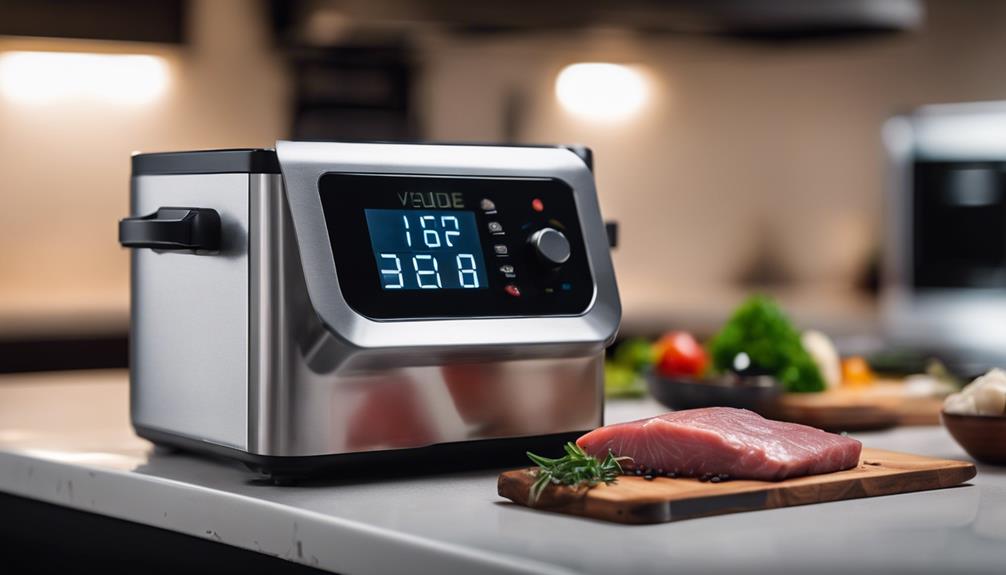
Maintain the quality and safety of your sous vide meals by ensuring they're reheated at the recommended temperature range of 130°F to 150°F. Reheating sous vide dishes at this important temperature helps preserve their quality and guarantees food safety.
To further assist you in reheating your meals effectively, here are some essential tips:
- Monitor the water bath temperature closely during reheating to prevent overcooking and maintain the desired doneness.
- Proper vacuum sealing of your sous vide meals is important to prevent contamination and ensure even reheating throughout the food.
- Recommended reheating times vary based on the type of food and its thickness, typically ranging from 30 minutes to a few hours.
- Following the recommended cooking and reheating times is essential to maintain food safety and quality when reheating sous vide meals.
- By adhering to these guidelines, you can prevent overcooking, preserve the quality of your meals, and ensure a safe dining experience for yourself and those you serve.
Thawing Frozen Sous Vide Meals
When thawing frozen sous vide meals, prioritize using the refrigerator to guarantee safe and even thawing without compromising food quality. Thawing at room temperature can lead to bacterial growth and pose food safety risks. By allowing the sous vide meals to thaw slowly in the refrigerator, you can maintain the texture and flavor, ensuring a better eating experience. Thawing in the refrigerator helps retain moisture and prevents the development of harmful bacteria, safeguarding the quality of your meal.
Planning ahead for thawing frozen sous vide meals is vital to make sure they're ready for reheating and serving without compromising taste or safety. Thawing in the refrigerator is a reliable method that keeps the meals at a safe temperature throughout the process. By following these practices, you can enjoy delicious sous vide meals with peace of mind, knowing that they've been thawed safely and correctly.
Maintaining Texture and Flavor
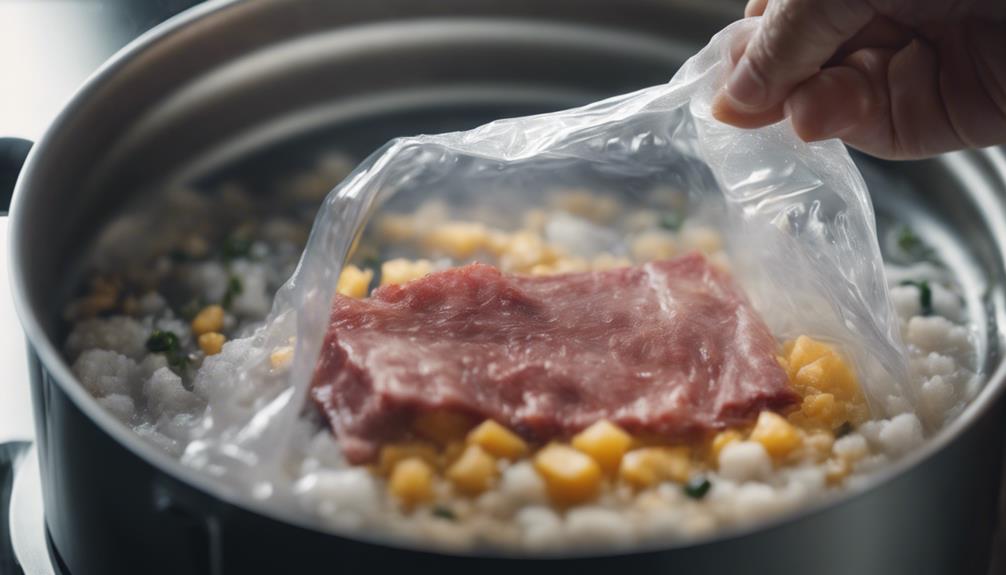
Maintaining the texture and flavor of sous vide meals is essential for a satisfying culinary experience. When freezing and reheating sous vide meals, following proper guidelines is crucial. Here are some key points to help you ensure optimal texture and flavor retention:
- Freezing and Reheating: Properly freezing and reheating sous vide meals is vital for preserving the food's original quality.
- Lower Temperatures: Reheating at lower temperatures can prevent overcooking and help maintain the texture and flavor of the meal.
- Monitoring: Keep a close eye on the reheating process to ensure that the food retains its moisture and taste.
- Guidelines: Following recommended guidelines for freezing and reheating sous vide meals is essential to achieve the best results.
- Flavor Retention: By following these steps diligently, you can optimize the retention of both the texture and flavor of your sous vide creations.
Frequently Asked Questions
Can You Freeze Food After Cooking Sous Vide?
You can freeze food after cooking sous vide to lock in freshness. Proper sealing and quick chilling help preserve texture and flavor. Thaw in the refrigerator for safety. Reheat efficiently using a sous vide machine for consistent results.
How Do You Reheat Frozen Food Sous Vide?
When reheating frozen food sous vide, guarantee proper thawing by submerging sealed bags in warm water. Control temperature for texture preservation. Use efficient reheating times for quick defrosting. Seal using vacuum bags for flavor retention. Try different reheating techniques.
Is Sous Vide Good for Reheating Food?
Sous vide is great for reheating food, keeping it moist and flavorful. Consistent temperature control avoids overcooking. Proper vacuum sealing is key for best results. Adjust seasoning for flavor balance. It's convenient for meal prep, ensuring safety.
Can You Sous Vide and Sear Later?
You can sous vide meals to perfection, then sear later for a fresh finish. Searing first locks in flavors and textures, offering time-saving convenience, quality control, and culinary creativity. It's a smart way to prep delicious dishes.
Conclusion
Overall, when it comes to freezing and reheating sous vide meals, proper cooling techniques, packaging tips, safe reheating temperatures, and thawing methods are crucial to maintaining the texture and flavor of your dishes.
By adhering to these best practices, you can guarantee that your sous vide meals remain delicious and safe to eat, even after being frozen and reheated.
So go ahead and enjoy the convenience of sous vide cooking without compromising quality!
